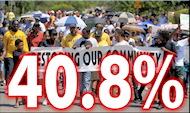Growing the Gap: Kansas' proposed education funding plan undermines urban and rural districts
I had always believed that the term "Undermining" was a colloquialism; a term that had come to represent the act of secretly working against the interest of others. That is until last year when I took a trip to Treece, Kansas and had the opportunity to see and understand that 'Undermining' is a real process with potentially dangerous consequences. My guides on the trip, Denny and Ella Johnston, walked me to the edge of what appeared to be a small pond. As we stood there on the waterfront, Denny explained to me how horizontal mine shafts had been drilled beneath homes, neighborhoods and businesses, weakening the ground. The residents at that time, had all been lead to believe that this was all perfectly safe and necessary, and that they could rest assured that there was no danger and they would suffer no ill-effects. For many years, those promises held true; these areas, though under-mined, appeared perfectly normal and life continued on as usual. But soon they all learned that given just enough rain and the right set of conditions, the mine shafts beneath them would flood and expand. Then suddenly, the ground gave way, and what used to be a neighborhood now became a sinkhole...
The proposed school funding plan, offered by the Kansas House Education Budget Committee, is an act of undermining. It would undermine urban schools, low SES students and districts by weakening their foundations, with real and painful consequences that would occur over time.
The Kansas Legislature is now facing a $400,000,000.00 shortfall. A proposed 1 cent sales tax which would have significantly reduced the deficit and provided much needed funds for education was defeated. The legislature has deferred any further decisions on cuts and rescissions until the wrap-up session (Apr 28th), but the House Education Budget Committee has already submitted a plan to the Kansas Department of Education which would reduce the State Education budget by $172,000,000.00.
While I was and remain personally supportive of the 1 cent sales tax increase (I believe that the conservative dogma that "cutting taxes creates growth" and "raising taxes kills jobs" are gross oversimplifications so out of sync with our economic climate and reality as to be fiscally irresponsible), but I digress... I am not philosophically opposed to cutting the budget, but I am truly disturbed by who the committee singled out to bear the brunt of those cuts. Far from trimming the fat, the House Education Budget Committee has submitted a plan that would widen disparities between districts and schools by focusing their cuts on districts with high percentages of Urban and ESOL students and those supported by neighborhoods with low property values.
The proposed plan divides the proposed cuts in half. Half of the cuts (approximately $86,000,000.00) would come from eliminating the high enrollment (read: urban) weighting, and reducing the vocational, bilingual, and at-risk weighting factors. The other half (roughly $86,000,000.00) would be cut from supplemental State aid; the funds used to equal out per pupil spending disparities across the State resulting from differences in local property tax receipts.
The cuts are disguised and their impact is not immediately discernible because the plan proposes that districts could simply increase their local property taxes to mitigate the impact. But the proposed taxes would all necessarily be regressive, because the lower a district's property values, the more its funding will be cut, and the more their local property taxes would have to be raised to make up the difference. The poorest districts would face the most severe cuts and would require massive tax increases to ever even approach parity in per pupil spending. Local Property tax increases so large, that they could never be passed...
Some will argue that supplemental state aid is a give-away. They will argue that it is only fair to provide communities with the schools and educational resources that they pay for, and that it is not fair to use tax money for the purpose of achieving statewide equities in per-pupil spending. - They are wrong -
You can not have it both ways. You can not claim to be supporters of fairness, level playing fields, and individual merit, and yet defend a system that distributes educational resources in concordance with personal wealth. If access to high quality/high experienced teachers, labs, equipment, state of the art facilities, art and music programs, extracurricular activities, field trips and other supplementary learning opportunities, are scaled to the parents income, then we will have a system that is not fair, with playing fields that are not level, and one where accomplishment is not based solely upon individual merit, but rather a system tilted to reward and benefit the affluent. That is not a Public school system; that is a tax supported Private school system...
Here are some examples of the disparate impacts of this proposalRequired Mill Rate Increases to replace the cuts.
USD 502 - 15.52 mil ~ USD 220 - 0.00 milUSD 396 - 16.05 mil ~ USD 328 - 0.00 milUSD 470 - 17.22 mil ~ USD 494 - 0.00 milUSD 339 - 18.79 mil ~ USD 424 - 0.00 milUSD 357 - 19.18 mil ~ USD 482 - 0.00 milUSD 337 - 20.01 mil ~ USD 209 - 0.00 milUSD 504 - 21.63 mil ~ USD 210 - 0.00 milUSD 505 - 22.14 mil ~ USD 203 - 0.00 mil
Get the picture?
In short, this proposal represents an unfair regressive tax scheme which will exacerbate disparities and shift the pain of this recession onto the backs of the working class, poor, urban, and minority communities. It is unbalanced, and it threatens to unbalance the quality of our children's education.
When the Legislature resumes on April 28th - URGE YOUR REPRESENTATIVES TO VOTE NO ON HOUSE BILL 2739











